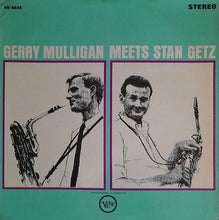Sonic Grade
Side One: 
Side Two: 
Vinyl Grade
Side One: Mint Minus Minus*
Side Two: Mint Minus Minus
- Mulligan and Getz's 1957 collaboration, here with solid Double Plus (A++) sound or close to it throughout this vintage 60s Verve Stereo pressing (one of only a handful of copies to hit the site in over three years)
- Full, rich, and spacious with an abundance of Tubey Magic and, better yet, not the least bit dry, hard or transistory (particularly on side two)
- Leave it to Better Records to figure out a complicated title with a long history such as this one - originals, reissues, monos, stereos, we had to play them all to find a copy that sounds as good as this one does (also particularly on side two)
- Practically impossible to find in stereo with audiophile playing surfaces, hence the multi-year hiatus away from the site
- "Produced by [Norman] Granz, Getz And Mulligan In Hi-Fi [the title it was originally released under] captures the two saxophone giants as they showcase a world class duet which provided them with a superb rhythm section featuring Lou Levy, proud member of The Stan Getz Quartet at the piano who play with impeccable style and well-conceived ideas that swing with unique vitality, while Ray Brown’s bass solidify the combo’s edge."

100% Money Back Guarantee on all Hot Stampers
FREE Domestic Shipping on all LP orders over $150
*NOTE: There is a mark that plays 6 times lightly at the start of track 1 on side 1, "Let's Fall In Love."
This vintage Verve stereo pressing has the kind of Tubey Magical Midrange that modern records can barely BEGIN to reproduce. Folks, that sound is gone and it sure isn't showing signs of coming back. If you love hearing INTO a recording, actually being able to "see" the performers, and feeling as if you are sitting in the studio with the band, this is the record for you. It's what vintage all analog recordings are known for --this sound.
If you exclusively play modern repressings of vintage recordings, I can say without fear of contradiction that you have never heard this kind of sound on vinyl. Old records have it -- not often, and certainly not always -- but maybe one out of a hundred new records do, and those are some pretty long odds.
What The Best Sides Of Gerry Mulligan Meets Stan Getz Have To Offer Is Not Hard To Hear
- The biggest, most immediate staging in the largest acoustic space
- The most Tubey Magic, without which you have almost nothing. CDs give you clean and clear. Only the best vintage vinyl pressings offer the kind of Tubey Magic that was on the tapes in 1957
- Tight, note-like, rich, full-bodied bass, with the correct amount of weight down low
- Natural tonality in the midrange -- with all the instruments having the correct timbre
- Transparency and resolution, critical to hearing into the three-dimensional studio space
No doubt there's more but we hope that should do for now. Playing the record is the only way to hear all of the qualities we discuss above, and playing the best pressings against a pile of other copies under rigorously controlled conditions is the only way to find a pressing that sounds as good as this one does.
Copies with rich lower mids and nice extension up top did the best in our shootout, assuming they weren't veiled or smeary of course. So many things can go wrong on a record. We know, we've heard them all.
Top end extension is critical to the sound of the best copies. Lots of old records (and new ones) have no real top end; consequently, the studio or stage will be missing much of its natural air and space, and instruments will lack their full complement of harmonic information.
Tube smear is common to most vintage pressings. The copies that tend to do the best in a shootout will have the least (or none), yet are full-bodied, tubey and rich.
Standard Operating Procedures
What are sonic qualities by which a record -- any record -- should be judged? Pretty much the ones we discuss in most of our Hot Stamper listings: energy, frequency extension (on both ends), transparency, spaciousness, harmonic textures (freedom from smear is key), rhythmic drive, tonal correctness, fullness, richness, three-dimensionality, and on and on down the list.
When we can get a number of these qualities to come together on the side we’re playing, we provisionally give it a ballpark Hot Stamper grade, a grade that is often revised during the shootout as we hear what the other copies are doing, both good and bad.
Once we’ve been through all the side ones, we play the best of the best against each other and arrive at a winner for that side. Other copies from earlier in the shootout will frequently have their grades raised or lowered based on how they sounded compared to the eventual shootout winner. If we’re not sure about any pressing, perhaps because we played it early on in the shootout before we had learned what to listen for, we take the time to play it again.
Repeat the process for side two and the shootout is officially over. All that’s left is to see how the sides of each pressing match up.
It may not be rocket science, but it’s a science of a kind, one with strict protocols that we’ve developed over the course of many years to insure that the results we arrive at are as accurate as we can make them.
The result of all our work speaks for itself, on this very record in fact. We guarantee you have never heard this music sound better than it does on our Hot Stamper pressing -- or your money back.
What We're Listening For On Gerry Mulligan Meets Stan Getz
- Energy for starters. What could be more important than the life of the music?
- The Big Sound comes next -- wall to wall, lots of depth, huge space, three-dimensionality, all that sort of thing.
- Then transient information -- fast, clear, sharp attacks, not the smear and thickness so common to these LPs.
- Tight, full-bodied bass -- which ties in with good transient information, also the issue of frequency extension further down.
- Next: transparency -- the quality that allows you to hear deep into the soundfield, showing you the space and air around all the instruments.
- Extend the top and bottom and voila, you have The Real Thing -- an honest to goodness Hot Stamper.
The Players
- Gerry Mulligan - baritone saxophone, tenor saxophone
- Stan Getz - tenor saxophone, baritone saxophone
- Lou Levy - piano
- Ray Brown - bass
- Stan Levey - drums
Vinyl Condition
Mint Minus Minus is about as quiet as any vintage pressing will play, and since only the right vintage pressings have any hope of sounding good on this album, that will most often be the playing condition of the copies we sell. (The copies that are even a bit noisier get listed on the site are seriously reduced prices or traded back in to the local record stores we shop at.)
Those of you looking for quiet vinyl will have to settle for the sound of other pressings and Heavy Vinyl reissues, purchased elsewhere of course as we have no interest in selling records that don't have the vintage analog magic of these wonderful recordings.
If you want to make the trade-off between bad sound and quiet surfaces with whatever Heavy Vinyl pressing might be available, well, that's certainly your prerogative, but we can't imagine losing what's good about this music -- the size, the energy, the presence, the clarity, the weight -- just to hear it with less background noise.
Side One
- Let's Fall In Love
- Anything Goes
- Too Close For Comfort
Side Two
- That Old Feeling
- This Can't Be Love
- Ballad
Amazon 5 Star Rave Review
Just as Stan Getz and Gerry Mulligan have enjoyed another terrific and truly rewarding year in 1957, they decided to take time to record a highly anticipated duet album for the Verve production label under the bold guidance of producer- impresario Norman Granz as they prepared for what would be highly described as “A Getz-Mulligan Meeting.”
Produced by Granz, Getz And Mulligan In Hi-Fi captures the two saxophone giants as they showcase a world class duet which provided them with a superb rhythm section featuring Lou Levy, proud member of The Stan Getz Quartet at the piano who play with impeccable style and well- conceived ideas that swing with unique vitality, while Ray Brown’s bass solidify the combo’s edge.
Highlighted by mostly preppy versions of classic standards, the track set begin with Let’s Fall In Love as it concludes head on with complex versions of Anything Goes, That Old Feeling, This Can’t Be Love and Scrapple From The Apple, while the original classic Ballad add to the musical merriment. What even solely adds up to the upbeat success of Getz And Mulligan In Hi-Fi is how the band gradually showcased their solid first class musicianship where Mulligan provides the rough and ready baritone saxophone solos full of robust phrases in excellent timing, while Getz’s tenor saxophone glistens and slides in complex accustomed fashion. Plus, you’ll get to hear Levy’s piano, Stan Levy’s drums and bass master Ray Brown perform with true equal billing, which made this classic duet masterwork a hit on the jazz charts upon its original release as the combo-led chemistry made it such a hugely enjoyable listening experience that will remain as fascinating and up to date as ever.
- RH




